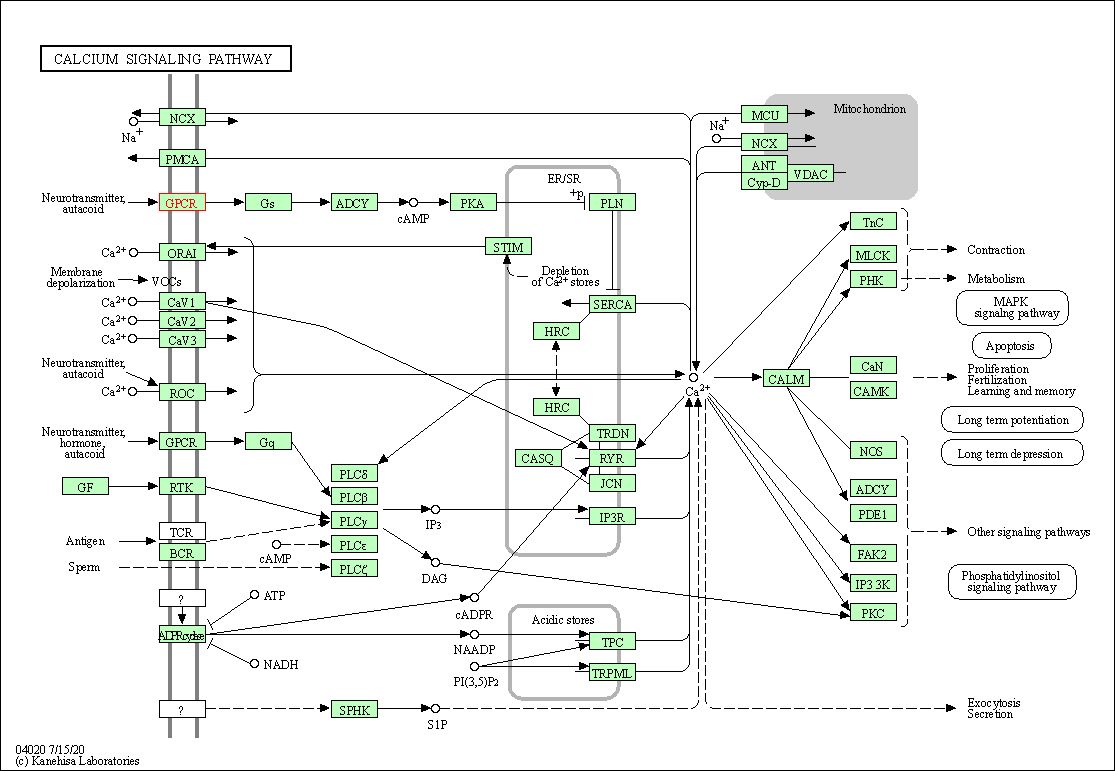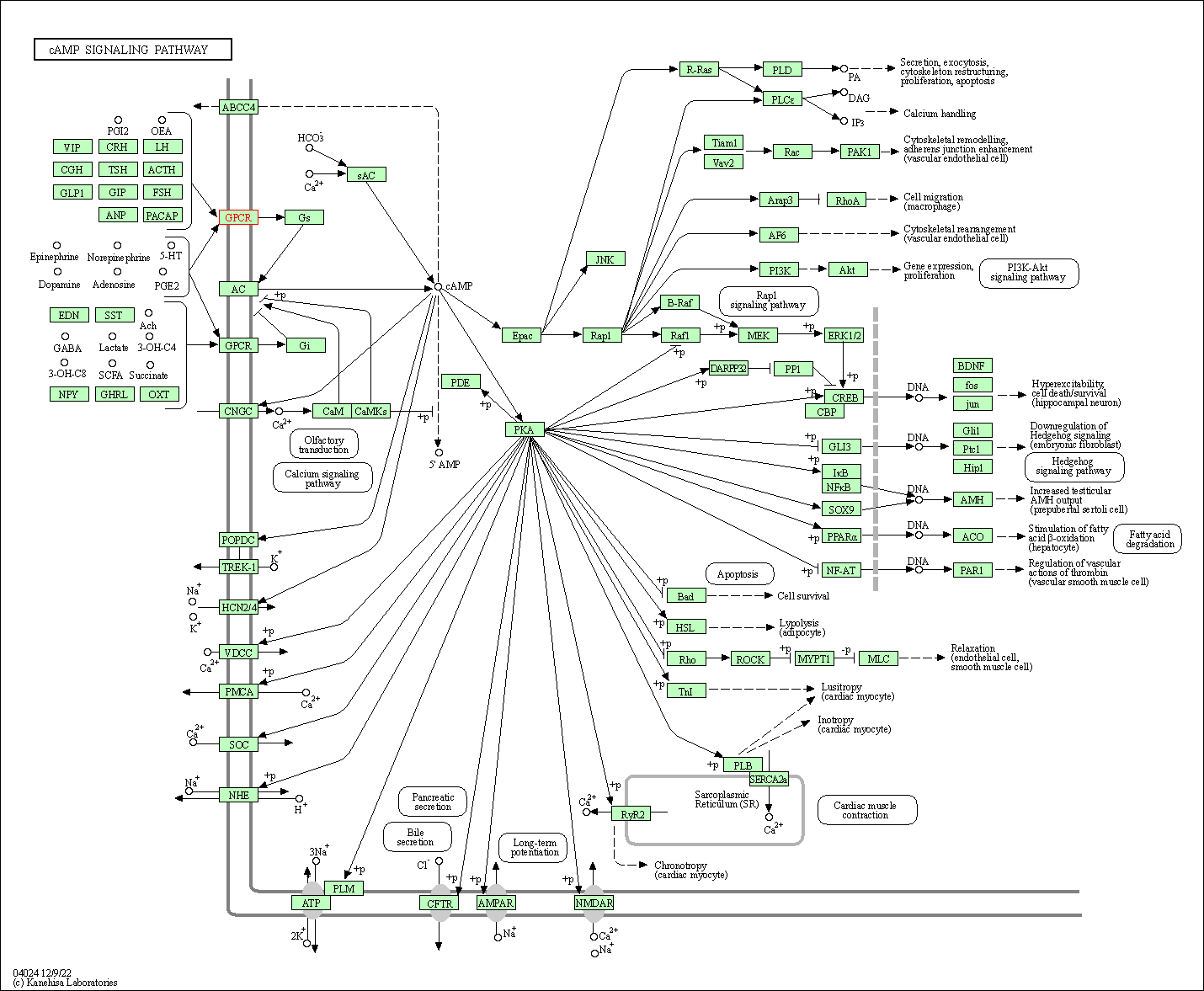Target Information
| Target General Information | Top | |||||
|---|---|---|---|---|---|---|
| Target ID |
T46828
(Former ID: TTDS00015)
|
|||||
| Target Name |
Dopamine D5 receptor (D5R)
|
|||||
| Synonyms |
Dopamine receptor 5; DRD5; D1beta dopamine receptor; D(5)D(1B) dopamine receptor dopamine receptor; D(5) dopamine receptor
Click to Show/Hide
|
|||||
| Gene Name |
DRD5
|
|||||
| Target Type |
Successful target
|
[1] | ||||
| Disease | [+] 1 Target-related Diseases | + | ||||
| 1 | Allergic/hypersensitivity disorder [ICD-11: 4A80-4A8Z] | |||||
| Function |
Dopamine receptor whose activity is mediated by G proteins which activate adenylyl cyclase.
Click to Show/Hide
|
|||||
| BioChemical Class |
GPCR rhodopsin
|
|||||
| UniProt ID | ||||||
| Sequence |
MLPPGSNGTAYPGQFALYQQLAQGNAVGGSAGAPPLGPSQVVTACLLTLLIIWTLLGNVL
VCAAIVRSRHLRANMTNVFIVSLAVSDLFVALLVMPWKAVAEVAGYWPFGAFCDVWVAFD IMCSTASILNLCVISVDRYWAISRPFRYKRKMTQRMALVMVGLAWTLSILISFIPVQLNW HRDQAASWGGLDLPNNLANWTPWEEDFWEPDVNAENCDSSLNRTYAISSSLISFYIPVAI MIVTYTRIYRIAQVQIRRISSLERAAEHAQSCRSSAACAPDTSLRASIKKETKVLKTLSV IMGVFVCCWLPFFILNCMVPFCSGHPEGPPAGFPCVSETTFDVFVWFGWANSSLNPVIYA FNADFQKVFAQLLGCSHFCSRTPVETVNISNELISYNQDIVFHKEIAAAYIHMMPNAVTP GNREVDNDEEEGPFDRMFQIYQTSPDGDPVAESVWELDCEGEISLDKITPFTPNGFH Click to Show/Hide
|
|||||
| 3D Structure | Click to Show 3D Structure of This Target | AlphaFold | ||||
| Drugs and Modes of Action | Top | |||||
|---|---|---|---|---|---|---|
| Approved Drug(s) | [+] 1 Approved Drugs | + | ||||
| 1 | Phenyltoloxamine | Drug Info | Approved | Allergy | [2] | |
| Preclinical Drug(s) | [+] 1 Preclinical Drugs | + | ||||
| 1 | LE-300 | Drug Info | Preclinical | Schizophrenia | [3] | |
| Discontinued Drug(s) | [+] 2 Discontinued Drugs | + | ||||
| 1 | GMC-283 | Drug Info | Terminated | Schizophrenia | [3] | |
| 2 | ZD-3638 | Drug Info | Terminated | Schizophrenia | [3] | |
| Mode of Action | [+] 4 Modes of Action | + | ||||
| Inhibitor | [+] 13 Inhibitor drugs | + | ||||
| 1 | Phenyltoloxamine | Drug Info | [1] | |||
| 2 | (+/-)-nantenine | Drug Info | [4] | |||
| 3 | 1-(4-(4-phenyl-1-piperazinyl)butyl)indolin-2-one | Drug Info | [5] | |||
| 4 | 1-Dibenzo[b,f]oxepin-10-yl-4-methyl-piperazine | Drug Info | [6] | |||
| 5 | 1-[2-(2-Benzyl-phenoxy)-ethyl]-piperidine | Drug Info | [1] | |||
| 6 | 1-[2-(2-Benzyl-phenoxy)-ethyl]-pyrrolidine | Drug Info | [1] | |||
| 7 | 1-[3-(2-Benzyl-phenoxy)-propyl]-pyrrolidine | Drug Info | [1] | |||
| 8 | 4-[2-(2-Benzyl-phenoxy)-ethyl]-morpholine | Drug Info | [1] | |||
| 9 | FLUMEZAPINE | Drug Info | [8] | |||
| 10 | FLUTROLINE | Drug Info | [9] | |||
| 11 | ISOCLOZAPINE | Drug Info | [6] | |||
| 12 | ISOLOXAPINE | Drug Info | [10] | |||
| 13 | STEPHOLIDINE | Drug Info | [11] | |||
| Antagonist | [+] 4 Antagonist drugs | + | ||||
| 1 | LE-300 | Drug Info | [3] | |||
| 2 | GMC-283 | Drug Info | [3] | |||
| 3 | SKF-83556 | Drug Info | [7] | |||
| 4 | [125I]SCH23982 | Drug Info | [12] | |||
| Binder | [+] 1 Binder drugs | + | ||||
| 1 | ZD-3638 | Drug Info | [3] | |||
| Agonist | [+] 2 Agonist drugs | + | ||||
| 1 | beta-ergocriptine | Drug Info | [7] | |||
| 2 | N-propylnorapomorphine | Drug Info | [7] | |||
| Cell-based Target Expression Variations | Top | |||||
|---|---|---|---|---|---|---|
| Cell-based Target Expression Variations | ||||||
| Different Human System Profiles of Target | Top |
|---|---|
|
Human Similarity Proteins
of target is determined by comparing the sequence similarity of all human proteins with the target based on BLAST. The similarity proteins for a target are defined as the proteins with E-value < 0.005 and outside the protein families of the target.
A target that has fewer human similarity proteins outside its family is commonly regarded to possess a greater capacity to avoid undesired interactions and thus increase the possibility of finding successful drugs
(Brief Bioinform, 21: 649-662, 2020).
Human Pathway Affiliation
of target is determined by the life-essential pathways provided on KEGG database. The target-affiliated pathways were defined based on the following two criteria (a) the pathways of the studied target should be life-essential for both healthy individuals and patients, and (b) the studied target should occupy an upstream position in the pathways and therefore had the ability to regulate biological function.
Targets involved in a fewer pathways have greater likelihood to be successfully developed, while those associated with more human pathways increase the chance of undesirable interferences with other human processes
(Pharmacol Rev, 58: 259-279, 2006).
Human Similarity Proteins
Human Pathway Affiliation
|
|
| KEGG Pathway | Pathway ID | Affiliated Target | Pathway Map |
|---|---|---|---|
| Calcium signaling pathway | hsa04020 | Affiliated Target |

|
| Class: Environmental Information Processing => Signal transduction | Pathway Hierarchy | ||
| cAMP signaling pathway | hsa04024 | Affiliated Target |

|
| Class: Environmental Information Processing => Signal transduction | Pathway Hierarchy | ||
| Neuroactive ligand-receptor interaction | hsa04080 | Affiliated Target |

|
| Class: Environmental Information Processing => Signaling molecules and interaction | Pathway Hierarchy | ||
| Dopaminergic synapse | hsa04728 | Affiliated Target |

|
| Class: Organismal Systems => Nervous system | Pathway Hierarchy | ||
| Chemical Structure based Activity Landscape of Target | Top |
|---|---|
| Drug Property Profile of Target | Top | |
|---|---|---|
| (1) Molecular Weight (mw) based Drug Clustering | (2) Octanol/Water Partition Coefficient (xlogp) based Drug Clustering | |
|
|
||
| (3) Hydrogen Bond Donor Count (hbonddonor) based Drug Clustering | (4) Hydrogen Bond Acceptor Count (hbondacc) based Drug Clustering | |
|
|
||
| (5) Rotatable Bond Count (rotbonds) based Drug Clustering | (6) Topological Polar Surface Area (polararea) based Drug Clustering | |
|
|
||
| "RO5" indicates the cutoff set by lipinski's rule of five; "D123AB" colored in GREEN denotes the no violation of any cutoff in lipinski's rule of five; "D123AB" colored in PURPLE refers to the violation of only one cutoff in lipinski's rule of five; "D123AB" colored in BLACK represents the violation of more than one cutoffs in lipinski's rule of five | ||
| Co-Targets | Top | |||||
|---|---|---|---|---|---|---|
| Co-Targets | ||||||
| Target Poor or Non Binders | Top | |||||
|---|---|---|---|---|---|---|
| Target Poor or Non Binders | ||||||
| Target Profiles in Patients | Top | |||||
|---|---|---|---|---|---|---|
| Target Expression Profile (TEP) | ||||||
| Target Affiliated Biological Pathways | Top | |||||
|---|---|---|---|---|---|---|
| KEGG Pathway | [+] 4 KEGG Pathways | + | ||||
| 1 | Calcium signaling pathway | |||||
| 2 | cAMP signaling pathway | |||||
| 3 | Neuroactive ligand-receptor interaction | |||||
| 4 | Dopaminergic synapse | |||||
| Panther Pathway | [+] 1 Panther Pathways | + | ||||
| 1 | Dopamine receptor mediated signaling pathway | |||||
| Reactome | [+] 2 Reactome Pathways | + | ||||
| 1 | Dopamine receptors | |||||
| 2 | G alpha (s) signalling events | |||||
| WikiPathways | [+] 4 WikiPathways | + | ||||
| 1 | Monoamine GPCRs | |||||
| 2 | GPCRs, Class A Rhodopsin-like | |||||
| 3 | GPCR ligand binding | |||||
| 4 | GPCR downstream signaling | |||||
| Target-Related Models and Studies | Top | |||||
|---|---|---|---|---|---|---|
| Target Validation | ||||||
| References | Top | |||||
|---|---|---|---|---|---|---|
| REF 1 | Dopamine/serotonin receptor ligands. 9. Oxygen-containing midsized heterocyclic ring systems and nonrigidized analogues. A step toward dopamine D5 ... J Med Chem. 2004 Aug 12;47(17):4155-8. | |||||
| REF 2 | Drugs@FDA. U.S. Food and Drug Administration. U.S. Department of Health & Human Services. 2015 | |||||
| REF 3 | The pipeline and future of drug development in schizophrenia. Mol Psychiatry. 2007 Oct;12(10):904-22. | |||||
| REF 4 | Synthetic studies and pharmacological evaluations on the MDMA ('Ecstasy') antagonist nantenine. Bioorg Med Chem Lett. 2010 Jan 15;20(2):628-31. | |||||
| REF 5 | Synthesis of novel lactam derivatives and their evaluation as ligands for the dopamine receptors, leading to a D(4)-selective ligand. Bioorg Med Chem. 2007 Sep 1;15(17):5811-8. | |||||
| REF 6 | Affinity of 10-(4-methylpiperazino)dibenz[b,f]oxepins for clozapine and spiroperidol binding sites in rat brain. J Med Chem. 1982 Jul;25(7):855-8. | |||||
| REF 7 | Cloning of the gene for a human dopamine D5 receptor with higher affinity for dopamine than D1. Nature. 1991 Apr 18;350(6319):614-9. | |||||
| REF 8 | Effects of conformationally restricted 4-piperazinyl-10H-thienobenzodiazepine neuroleptics on central dopaminergic and cholinergic systems. J Med Chem. 1982 Oct;25(10):1133-40. | |||||
| REF 9 | Neuroleptic activity in 5-aryltetrahydro-gamma-carbolines. J Med Chem. 1980 Jun;23(6):635-43. | |||||
| REF 10 | Synthesis of clozapine analogues and their affinity for clozapine and spiroperidol binding sites in rat brain. J Med Chem. 1981 Sep;24(9):1021-6. | |||||
| REF 11 | Dibenzazecine scaffold rebuilding--is the flexibility always essential for high dopamine receptor affinities Bioorg Med Chem. 2009 Oct 1;17(19):6898-907. | |||||
| REF 12 | URL: http://www.guidetopharmacology.org Nucleic Acids Res. 2015 Oct 12. pii: gkv1037. The IUPHAR/BPS Guide to PHARMACOLOGY in 2016: towards curated quantitative interactions between 1300 protein targets and 6000 ligands. (Target id: 218). | |||||
If You Find Any Error in Data or Bug in Web Service, Please Kindly Report It to Dr. Zhou and Dr. Zhang.

